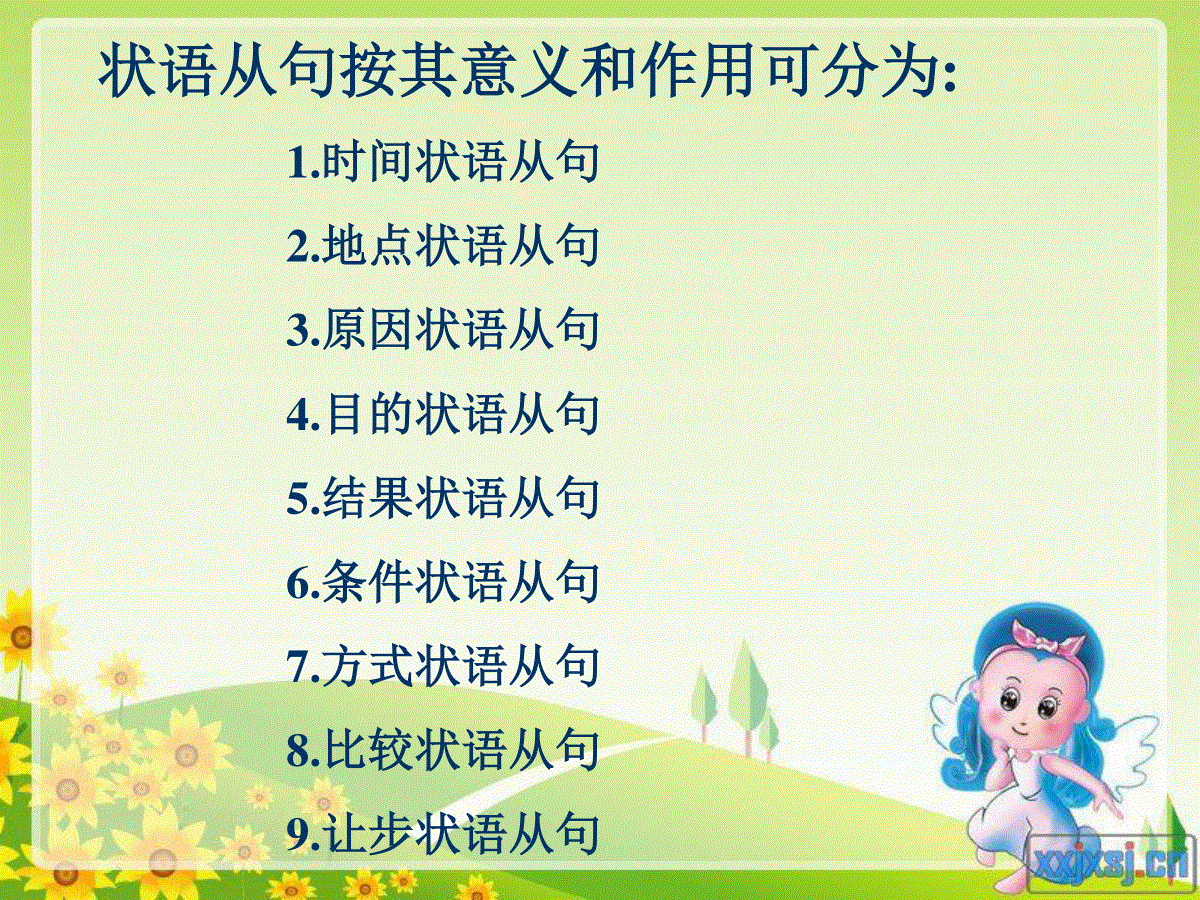当前位置:首页 > 商业/管理/HR > 管理学资料 > 高一英语语法《状语从句》PPT课件
状语从句按其意义和作用可分为:1.时间状语从句2.地点状语从句3.原因状语从句4.目的状语从句5.结果状语从句6.条件状语从句7.方式状语从句8.比较状语从句9.让步状语从句引导时间状语从句的从属连有:when,while,as,whenever,before,after,since,till,until,assoonas,once,hardly…when,nosooner…than等引导。如:1、时间状语从句引导时间状语从句的从属连词有:when,while,as,whenever,before,after,since,till,until,assoonas,once,hardly…when,nosooner…than等引导。如:Whenhewasstillayoungman,hewasforcedtoleavehishomelandforpoliticalreasons.Ithasbeen15yearssinceheleft.I’lltellhimthenewsassoonasIseehim.Onceyouhavegotusedtoit,youwilllikeit.Iwaitedtillhehadfinishedhiswork.注意:(1)when,as,whilewhen即可引导持续性动作,又可引导短暂性动作。它可以表示主句的动作和从句的动作同时发生,或从句的动作发生在主句动作之前。如:as引导持续性动作,侧重主句和从句的动作同时发生。Hehurriedhome,lookingbehindashewent.Isawyoursisterasshewasgettingonthebusyesterday.Hesangashewalked.as也可表示“随着”,但要注意与with的区别:as是连词接句子。with是介词,接词或词组。Asthedaywenton,theweathergotevencold.(从句,故用谓语动词)Withthedaygoingon,theweathergotevencold.(介词,故用非谓语)While:指的是“在某一时间里”,“在……期间”,从句里的动作必须是持续性的,它也强调主句和从句动作的同时发生,往往侧重主句和从句动作的对比。如:WhilehewasinLondon,hestudiedmusic.WhilewewerewatchingTV,hewaswritingacomposition.while也可做并列连词,表示对照的含义,意思为“然而”。如:Heistallwhilehisbrotherisshort.当when,as,while表示“在…一段时间里”,主从句的动作同时发生时,可以换用。如:While(When或As)wewerediscussing,Mr.Smithcamein.(2)如果when和before引导的从句位于主句之后,有时不能译成“当…时候”和“在…之前”,而要译成“就”、“才”、“这时”等。如:ThestrugglelastedfouryearsbeforetheNorthwonintheend.Healmostknockedmedownbeforehesawme.Shehadnotbeenmarriedmanyweekswhenthemansawherandwasstruckbyherbeauty.IwaswalkinginthestreetwhenIsawhim.before的句型:Itwon’tbelongbeforesb.doessth.不用多久某人就会……Itwillbelongbeforesb.does要过很久某人才会……Itwaslongbeforesb.didsth.过很久某人才做……Itwillbe+一段时间+beforesb.does某人要过多长时间才做Itwas+一段时间+beforesb.didsth.某人过了多长时间才做(3)bythetime,eachtime,everytime,immediately,themoment,theinstant,theminute,soonafter,shortlyafter都可以作为连词,引导时间状语。如:Bythetimehewasfourteen,hehadtaughthimselfadvancedmathematics.bythetime+现在时,主句用将来完成时.例如:Bythetimehearrives,wewillalreadyhaveleftCalifornia.bythetime+一般过去时,主句用过去完成时.例如:Bythetimehearrived,wehadalreadyleftCalifornia.Eachtimehecame,hewouldcallonme.Youmustshowhiminimmediatelyhecomes.IrecognizedhimthemomentIsawhim.(4)till和until①如果主句谓语动词是持续动词,通常用肯定式的主句,表示“直到…为止”。如:Iworkedtill(until)hecameback.②如果主句谓语动词是瞬间动词,则用否定式的主句表示“直到…才,如:Ididn’tgotobeduntil(till)hecameback③放在句首表示强调时一般用until。如:Untilhereturns,nothingcanbedone.注意:–Notuntilhismothercalleddidhegetup.(不倒装为Hedidn’tgetupuntilhismothercalled.)Itwasnotuntilhismothercalledthathegotup.(notuntil的强调结构为itis/wasnotuntil…that…)(5)用nosooner…than和hardly…when引导的从句表示“刚……就……”,主句中的动词一般用过去完成时,从句用过去时若把nosooner,hardly提到句首,主句倒装例如:Hehadnosoonergottothelabthanhesetouttodotheexperiment.该句倒装为:Nosoonerhadhegottothelabthanhesetouttodotheexperiment.(5)时间状语从句中谓语动词不能用任何一种将来时,只能用现在时和过去时表示将来时。2、地点状语从句:通常由连词where和wherever等引导。如:Gobackwhereyoucamefrom.Whereveryougo,youmustwritetoyourparents.Wherethereisawill,thereisaway.Wherethereistoomuch,thepoisonandwastemaydogreatharmtothethingsaroundus.注意:不要和where引导的定语从句相混淆.例如:Weshallgowhereworkingconditionsaredifficult.Weshallgototheplacewhereworkingconditionsaredifficult.(状语从句)(定语从句)3、原因状语从句:通常由连词:because,as,since,nowthat引导。区别是:because:表示“因为”,直接而明确的原因和理由,语气最强,why提问的句子,一般都用because回答。Hedidn’tcomebecausehewasill.注意:①在强调句中强调原因状语从句,只能用because引导,不可用as或since,如:Itwasbecausehewasillthathedidn’tgowithus.②because可以引导表语从句,而as,since不可以,但仅用于以下句型:This/That/Itisbecause……It’sbecauseheistoolazy.since:表示“既然”,语气比because弱。Sinceyouarehere,youmustdoit.as:表示“因为”语气比because轻,引导从句可放主句前也可放主句后。Youneedn’tgowithme,asyouarebusy.AsIwasafraid,Ihidmyself.nowthat意思与since相似,表示“既然”。NowthatyouareinHighSchool,youwillprobablyspendmoreinreading.Nowthatalltheguestshavearrived,let’shaveourdinner.③for也表示“因为”,但是并列连词,它连接的不是状语从句,语气比较强。For引导从句不说明主句发生的直接原因,只是提供一些补充说明,且不位于句首.Itmustbemorning,forthebirdsaresinging.seeingthat(既然)和inthat(因为)Seeingthattheweatherisbad,we’llstayathome.Ilikethecity,butIlikethecountrybetterinthatIhavemorefriendsinthecountry.4、目的状语从句:通常由that,sothat,inorderthat,so…that,lest(以免,以防),incase(以防、免得),forfearthat(以免)等引导:Hegotupearlyinorderthathecouldcatchtheearlybus.Shemarriedhimsothatshemighttendandcomforthim.Iexplainedagainandagainincaseheshouldmisunderstandme.lest,incase,forfearthat后面常用虚拟语气,也就是说其引导的状语从句常用“(should)+动词原形”。例如:Ihidthebooklest(=forfearthat)heshouldseeit.※目的状语从句中谓语动词常含有may(might),can(could)should,will等情态动词。5、结果状语从句:由that,sothat,so…that,such…that引导:Itwasverycold,sothattheriverfroze.Thebookissowrittenthatitgivesaquitewrongideaofthefacts.Thereweresomanypeople(=suchalotofpeople)intheroomthatwecouldnotgetin.Hemadesuchanexcellentspeechthateveryoneadmiredhim.注意:sothat既可引导目的状语从句,又可引导结果状语从句,其区别在于:引导结果状语从句时通常用逗号同主句分开.Hemadeawrongdecision,sothathalfofhislifetimewaswasted.(结果状语从句)Theystartedearlysothattheymightarriveintime.(目的状语从句)6、条件状语从句:由if,unless,aslongas(=solongas)(只要),incase(that)(如果,万一),suppose(that),supposing(that),given(that)(在……的情况下,假定),grantedthat(就算),onconditionthat,providedthat,providingthat等引导:例如:IshallnotgotothecinemaunlessIfinishmyhomeworkbeforeeight.Youmaygoswimmingonconditionthatyoudon’tswimtoofarawayfromtheriverbank.Aslongasyoukeepontryi





 三七文档所有资源均是用户自行上传分享,仅供网友学习交流,未经上传用户书面授权,请勿作他用。
三七文档所有资源均是用户自行上传分享,仅供网友学习交流,未经上传用户书面授权,请勿作他用。
本文标题:高一英语语法《状语从句》PPT课件
链接地址:https://www.777doc.com/doc-4854251 .html